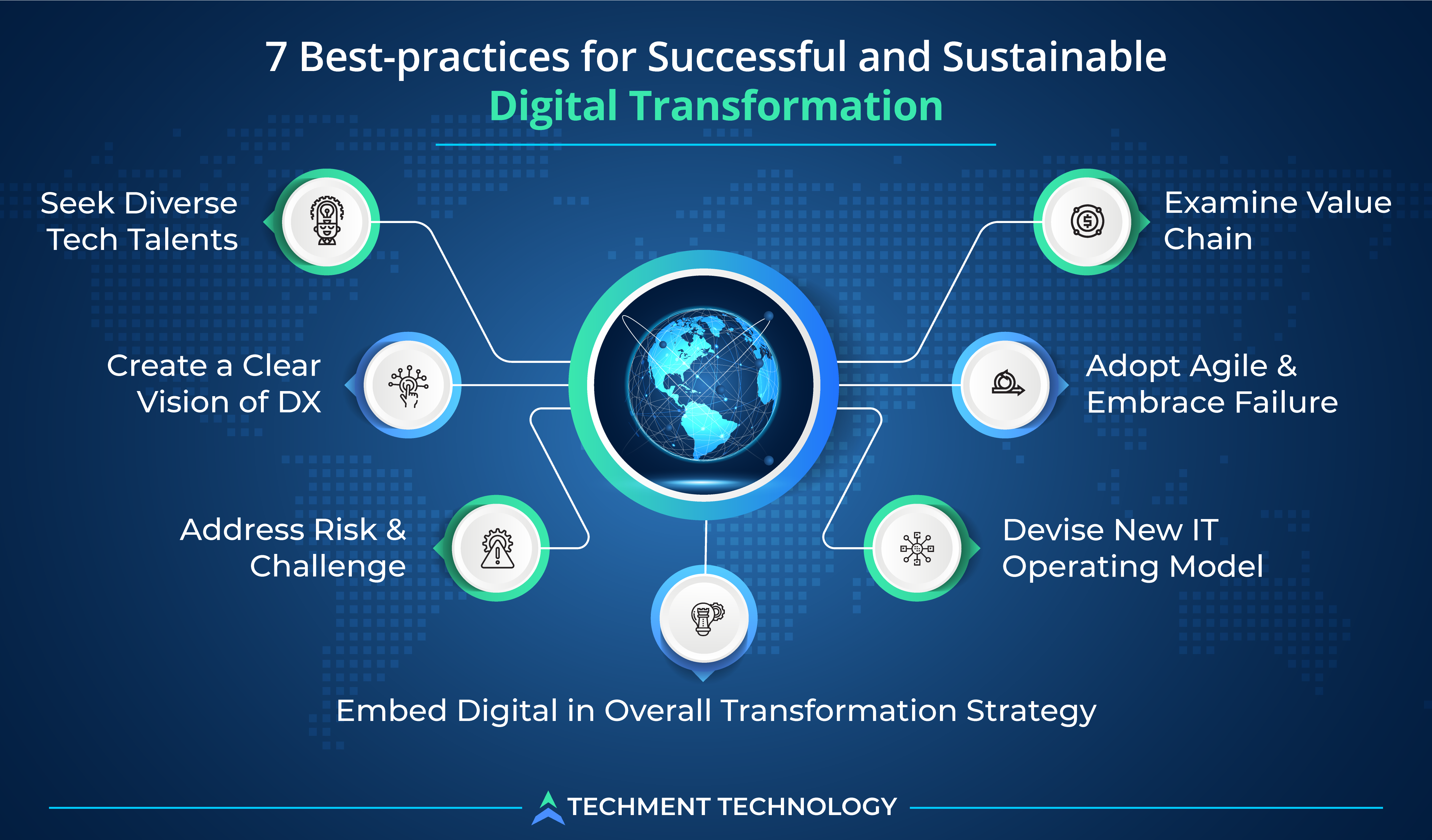Digital Transformation Stems from Digital Readiness
Digital transformation (DX) being a tenet of IT, has led organizations to adopt more digital technology, to gain momentum in the business. As digital technologies are reshaping industries, business leaders need to convert their visionary steps into a clear set of digital initiatives that takes organization towards transformation.
All digital-savvy industries like media, telecommunication, etc., pushed by bandwagon practices have spent a sizable amount and found it challenging to bring digital transformation. The growing demand for advanced technologies such as IoT is promoting the adoption of data-rich and analytics solutions. According to Grand View Research, the global digital transformation market size is expected to grow at a CAGR of 23.6% from 2021 to 2028.
The direct digital transformation investment from 2020 to 2023 is expected to approach $ 6.8 trillion, according to IDC.
Given the incredible growth in DX investments, the real challenge is to figure out a coherent set of strategies that creates meaningful impact and then rallies the organization from all corners, requiring coordinated efforts at all levels.
The pandemic has forced IT organizations to shrink timelines and accelerate efforts to operate their workforce remotely, as well as address the security challenges. As the pandemic continues, IT leaders are facing challenges to position their business for the new digital normal, to maintain the post-pandemic momentum, and to prepare their teams for success. Exposure to the best practices can help companies prop up their success in digital transformation.
7 Best-practices for Successful and Sustainable Digital Transformation
The real touchstone of successful digital transformation is improved customer experience where companies’ focus must line. Competing in the digital world means transforming both tech stacks, operating models and figuring out winning patterns like digital foundation, the landscapes, how to digitally modernizing tech infrastructure, and addressing customer demands and competitive pressure.
Prioritizing the following practices will underlay a strong foundation for digital transformation:
1. Create a Clear Vision of DX: Developing a vision that resonates with the internal growth strategy of the company and one which creates a sense of urgency, is the first step towards digital transformation. The real benefit of transformation comes from creating a vision for the future, communicating it in the organization, seeing the potential synergies from silos, and providing opportunities where everyone can unlock values.
2. Seek Diverse Tech Talents: Transformation isn’t only about technologies but more about bridging the gap between organizations’ need for tech talents and actually finding them Above all organizational structure, technology, and processes, DX requires talents enabling change for desired digital maturity and enterprise-wide impact. Metros are certainly having a higher concentration of talents but compete with tier-II cities especially post-pandemic. Value proposition and inspiring vision motivate talents from tier-II cities and organizations are flourishing there to preserve stable teams.
To know more about the advantages of companies in tier-II cities, read here
3. Examine Value Chain: The design, development, and manufacturing of products and services create synergy with new technologies. Value chain analysis drives digital innovation which helps to understand that your business needs more than new offerings. Examine what values your company creates before getting into the transformation.
Usually, value chain mapping leads to rapid innovation, better user experience, and clears the scope and need for new technologies. By putting all of these together, IT brings digital transformation.

4. Embed Digital in Overall Transformation Strategy: Incorporating digital in overall business strategy is an important digital readiness parameter to achieve success. Digital transformation begins with answering critical questions such as what, why, how, and who. A digital transformation strategy builds bridges between the current state and the desired long-term plan, with information, data, processes, technologies, human aspects, and more.
The basic things to examine to operationalize digital transformation strategy are:
- What are long-term objectives and intermediate objectives?
- What does your company want to achieve?
- Who needs to be involved in strategies?
- Defining connecting nodes to achieve those objectives?
- How are customers involved in new business development?
- What parameters will drive ROI with a new business strategy?
The dimensions expand when there are more actionable opportunities.
5. Devise New IT Operating Model: Instead of working on separate initiatives within organizational units, companies need to think about how their operations can help deliver a distinctive customer experience. The best way to do this is to focus on the customer journey and the internal processes, and move towards NextGen IT operating models.
For companies, it is imperative to tie CX across different channels and multiple functions. Most traditional operating models cannot handle continuous change but the influence of the NextGen IT operating model is so great that companies may have to change their core business models in order to survive.
6. Adopt Agile & Embrace Failure: Using digital transformation to gain competitive advantage often means your business model needs to adapt. An agile business will achieve this by taking constant and iterative action towards its goal. The “agile” methodology is well integrated into the technology of most companies and project management teams today, but this approach is just as valuable when adopted at the organizational level.
Agility means doing something new, finding out how it works, and evaluating whether it is achieving the desired results. This approach is extremely valuable for today’s businesses looking for digital readiness.
“Technology requires constant hands-on management to ensure that the business is adapting to the change in its DNA – and to ensure that future shifts, both internal and external, are accompanied by the appropriate flex of its tech stack”, — Maria Martinez, Chief Operating Officer, Cisco
7. Address Risk & Challenges: When migrating, it is important to address risk and develop a risk management strategy. In a strong risk-management culture, the behavior of individuals and groups within an organization defines its approach to risk-taking.
Understanding the risk before stepping into digital transformation is a critical area to deal with, whether it is failure due to obsolete technologies, unauthorized usage, inadequate controls in operations, or inappropriate handling of sensitive information.
For better risk mitigation:
- Analyze the digital footprints and impacts.
- Develop a framework to deal with failure in functionality.
- Plan digital enablers for better risk governance.
- Monitor the regulatory requirements.
While IT will play an important role in driving the digital transformation strategy, the work of implementing and adapting to the massive changes accompanying digital transformation is up to everyone. Digital transformation initiatives often reshape workgroups and business processes.
Aligning Digital Capabilities with Company’s Vision will Ramp-up Digital Transformation Success Rate
COVID19 was the catalyst that forced many companies to design transformational strategies and adopt technologies to support a new remote workforce, even though they weren’t ready. Digital transformation capabilities seek organizational boundaries as well in terms of the right mix of capabilities, whether the technologies can meet specific challenges, and whether they would be able to match the speed of execution required.
Be Agile: Companies undergoing a digital transformation journey have to adopt an agile way of working removing barriers to long-established industrial processes. Working towards the twin strategy of growing business and developing the digital capabilities is significant but also critical to keep the two connected. Hence, such a risky endeavor of creating a close relationship between DX and business goals needs responsible steps.
Exhibit Persistence Within Organization: Digital transformation is something that brings challenges every day and being at the cusp of DX, companies must expand their horizon across different segments within the organization first. To ride the current wave of digital transformation and stay agile and competitive in the future, companies need to constantly monitor the changing environment, to test existing business practices, assumptions, and other biases so that digitalization can help fuel growth by adapting to customer needs.
 All Posts
All Posts


